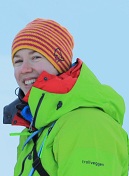[an error occurred while processing this directive]  |
Heidi Sevestre
 Associated SVALI PhD student Associated SVALI PhD student
Heidi Sevestre started her PhD at the Univercity Centre in Svalbard in 2011. She will be working with assesing the current state of surge-type glaciers and ultimately develop a single model of glacier surge.
Host institute: The University Centre in Svalbard Degree granting institute: University of Oslo
Supervisors: Prof. Doug Benn, Prof. Jon Ove Hagen.
Theme 1: Observing the present - baseline and changes
- WP 1.2: Changes in ice dynamics
Theme 2: Understanding the physical processes
- Work package 2.1: Glacial and subglacial hydrology
- Work package 2.3: Interaction of atmospheric, cryospheric and hydrological processes at glacier surfaces
This project will use an approach combining remote sensing, fieldwork and modeling to re-define glacier surging, assess the current state of the world’s surge-type glaciers, and ultimately develop a single model of a glacier surge. Remote sensing analyses will provide data to build a global dataset of surge-type glaciers; dataset completed with detailed information on the glaciers topographic and climatic contexts. Fieldwork will be associated to remote sensing to focus on the arctic ring, and more particularly on two of its long-studied surge clusters: Iceland and the Svalbard archipelago. Such data will be essential to parameterize a model of glacier surging based on a new energy budget approach, which aims to understand the ‘non-random’ distribution of surge-type glaciers, and to establish the surge response to climatic and topographic controls.
Aims and objectives
The aims of this project are to identify and assess the current characteristics of the entire surge-type glaciers population in order to redefine the notion of surging, its dynamics and processes, and also to quantify the evolution of surging by comparison to earlier studies. With the development of such a global dataset on surging, combined with fieldwork in Svalbard and Iceland, we aim to calibrate a new model of the surge based on oscillations in mass and energy storage dissipation. The model ultimately aims to establish first the relationships between the glacier’s surging behaviour and its topographic and climatic contexts, and secondly to understand why ‘normal’ glaciers (i.e. non-surge type glaciers) do not need to surge. Thus, the project has two key objectives:
- Creation of a worldwide-scale statistical survey on surge-type glaciers with emphasis on the arctic ring (Svalbard and Iceland), based on previous publications, remote sensing and field data.
- Development a single surge model reflecting the influence of the glacier’s topography and climatic environment.
Contact info:
|